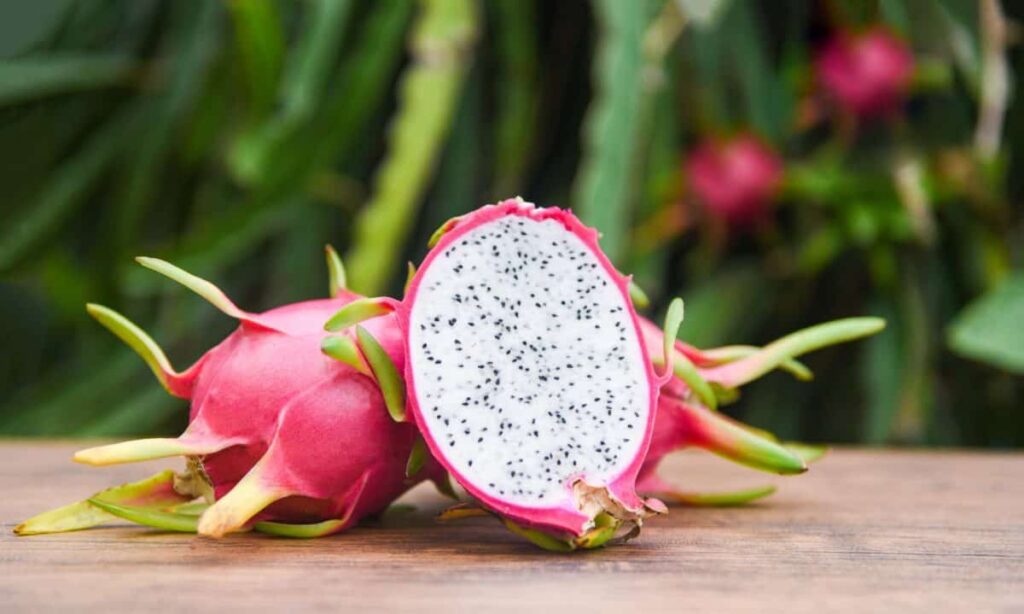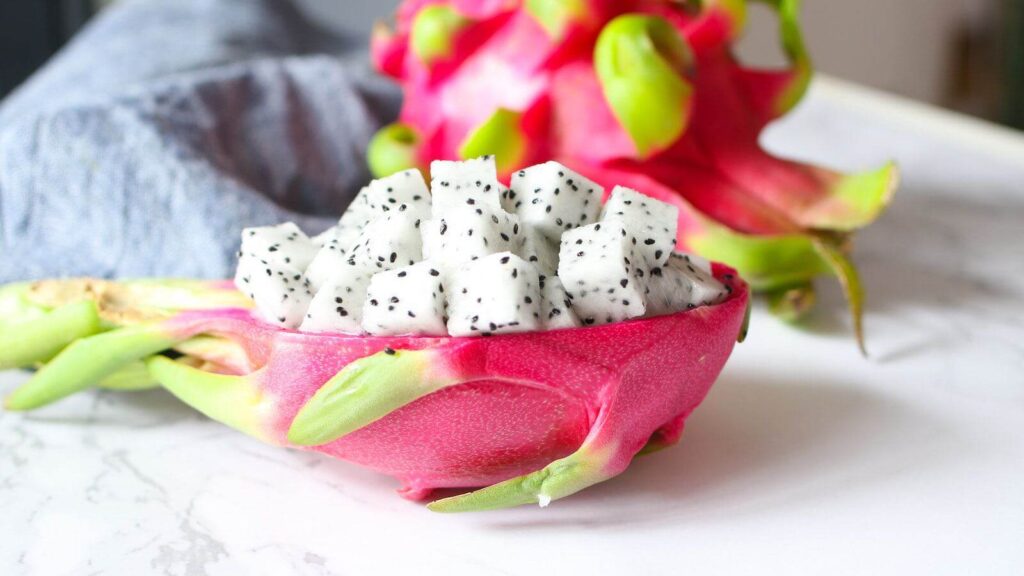Dragon fruit is a mild-tasting tropical fruit that is easy to cut and eat, and beautiful to behold. Here’s everything you need to know about it: How to cut a ripe dragon fruit, test a dragon fruit for ripeness, and lots more.
What Is Dragon Fruit?
Dragon fruit is from the Cactus family. Originally native to Central and South America, this beautiful looking fruit bears no resemblance to the cactus we have on the kitchen window sill (thankfully:) and is delicious.

My kids were slightly skeptical to start with. It’s so different looking to the fruit they’re used to having, although the little ones were delighted by the look of it, it took a bit more convincing to get them to eat it! The flesh is creamy and fresh, and is dotted with Dragon fruit seeds, a bit like a Kiwi is.
How to Pick Out a Good Dragon Fruit
When buying dragon fruit, look for shiny, bright pink flesh with fresh green tips. Avoid dragon fruit that looks wrinkled or has blemishes or brown coloring.
When Is Dragon Fruit Ripe?
Here’s how to tell if a dragon fruit is ripe:
- Ripe dragon fruit has a bright pink color with smooth skin
- The dragon fruit should not be rock hard. Instead, let it ripen a little until the flesh gives a little big, similar to a ripe avocado.
- If the dragon fruit feels mushy, it is overripe.
How to Cut a Dragon Fruit
Dragon fruit is covered in prickly leaves, but it’s easier to cut through than you might imagine. The skin is thin and smooth, similar to a mango. Beneath the skin, you’ll find a soft pliable peel that easily separates from the fruit. Here’s how to cut it:

First, rinse off the dragon fruit to ensure it’s cleaned off thoroughly.
Place the dragon fruit on a cutting board. Use a sharp knife to cut the fruit in half lengthwise. You can stop right here if you choose and eat the pulp straight out of the skin with a spoon.
Alternatively, you can remove the fruit from the skin. To do this, you have two options. You can use a large spoon to scoop out the flesh, similar to an avocado.
Or, cut the fruit in half again lengthwise and use your fingers to peel the skin away from the fruit on each of the quarters.
Once you’ve removed the skin using either method, you can cut the fruit into smaller pieces. To cut into slices, take one half of the fruit and make slices every quarter inch.
Or, cut it into cubes. Begin with slices and then turn the fruit 90 degrees and cut in the opposite direction.
What Does Dragon Fruit Taste Like?
Dragon fruit looks vibrant and gorgeous. Its flavor is a little . . . neutral. Most people compare it to a cross between mild kiwi and pear. Because of its mild flavor, some people may consider it a little bland.

Because of its mild flavor, I like to combine dragon fruit with other fruit to make a larger fruit salad or platter, instead of eating one on its own.
Is Dragon Fruit Healthy?
Yes! Like other fruit, dragon fruit contains fiber, antioxidants, vitamins, and minerals. Dragon fruit is especially rich in fiber, vitamin C, and magnesium.
This pretty tropical fruit may look unfamiliar — even a little intimidating. But once you know more about it, you’ll see just how easy it is to cut, eat, and enjoy dragon fruit.
Health Benefits of Dragon Fruit
Dragon fruit is loaded with nutrients and has many impressive health benefits including:
- Beneficial antioxidants like vitamin C.
- 7 grams of fiber per cup along with prebiotics for a healthy gut and digestive health.
- Plant compounds like polyphenols and carotenoids that help to strengthen the immune system.
- Beneficial minerals like iron and magnesium.
Notes
- Storing: Place cut pieces in an airtight container for up to 2 to 5 days. Discard once the flesh becomes brown or mushy.
- Freezing: Cut into ½ to ¾-inch pieces. Store in a single layer in a large resealable bag. Fruit can be frozen for up to 12 months.